
- Forum Listing
- Marketplace
- Advanced Search
- About The Boat
- Boat Review Forum
- SailNet is a forum community dedicated to Sailing enthusiasts. Come join the discussion about sailing, modifications, classifieds, troubleshooting, repairs, reviews, maintenance, and more!

DS 20 performance
- Add to quote
Antone know or own this boat? It's a 20 foot, 1850 lbs displacement swing keel boat with 185 square feet of sail. It is said to be slow by some who have owned one. Just wondering how slow? Also what makes a design slower than another? Is it mainly displacement vs. sail area? Does swing keel = slow? Hull shape has something to do with it I am sure too. Thanks, Eric
Attachments
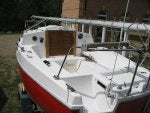
looks like a cute little boat. swing keel does not becessarily equal slow.
Here is a pic from the original brochure....
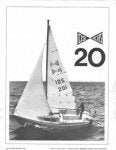
PHRF average is 285, which puts it slower than the Balboa 20 or ComPac19, both famously pokey boats. But who cares? All sailboats are slow. You can pay $10 million for the latest canting-keel, carbon fiber racer and go as fast as ... a person on a bicycle. So once you get your head around that, it becomes a matter of HOW slow a sailboat is -- and more importantly, how slow it feels. A Hobie 14 is slow, a Sunfish is slow -- but they sure feel like they are ripping along. Helm response, acceleration, heeling, pitching all contribute to a boat's feeling of excitement. Hard to advise on that. From the picture you posted, I'd say the mast is short and the mainsail very small, roachless. Can't even see the purpose of that first set of reef points. Long spreaders and jibsheets outside the shrouds suggest it's hard to get a fine slot between the sails; that'll rob your power. It's a beamy bugger that carries its width well aft, so it'll be stable but with some drag. Cockpit looks comfy, nice fat rails to sit on, looks like a recessed traveler mid-boom. Appears well set up and ready to sail. I like it. If you can arrange a test sail, see if it feels heavy or quick. Edit: just noticed the red boat in your first post lacks the traveler; may be set up for boom-end sheeting. on this boat, I'd call that a demerit. Not a huge one, but still.
The only other boat I have sailed (crewed really) close to this size was an Edel 540. How does this boat compare to it for speed? Here are some more specs: LOA: 20'5" Beam: 7'7" Headroom: 4'10" LWL: 18'1" Draft 22" Sail Area: 185 sq. ft. Displacement: 1850 lbs. Ballast: 650 lbs Another pic. The keel is a swing keel but I think it swings into this shoal looking keel. Not sure about how the main is sheeted. I am going to look at the boat this weekend. It's only $1500.00 but is supposed to be in good condition. We will see. I thinks it's been painted all over. I am not holding my breath. Anyone know what the little blackboard on the right side of the transom is?
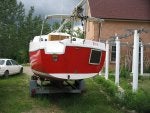
AllThumbs said: The only other boat I have sailed (crewed really) close to this size was an Edel 540. How does this boat compare to it for speed? Here are some more specs: LOA: 20'5" Beam: 7'7" Headroom: 4'10" LWL: 18'1" Draft 22" Sail Area: 185 sq. ft. Displacement: 1850 lbs. Ballast: 650 lbs Another pic. The keel is a swing keel but I think it swings into this shoal looking keel. Not sure about how the main is sheeted. I am going to look at the boat this weekend. It's only $1500.00 but is supposed to be in good condition. We will see. I thinks it's been painted all over. I am not holding my breath. Anyone know what the little blackboard on the right side of the transom is? Click to expand...
Where are you getting thos PHRF numbers? You have a link to a website?
http://www.ussailing.org/phrf/Tool_ HI_LO_AVG Report.pdf Here is US Sailings hi, low ae ratings for a number of boats. I have not looked to see if this boat is on the list. To me anyway, this boat looks like it could be a good boat depending upon what it is your after. For $1500, you should be able to sell her for what you paid for, maybe a bit more if it needs some cleaning up on the inside. Outside, looks good, but as you mention, it may be new paint, which in and of itself, is not all bad either! Marty
Hey, my current boat is listed there. A Scirocco 15 (miss-spelled tho, it should be Sirocco 15). It is listed as a PHRF of 348. This means the DS 20 is the faster boat? Eric
Yep. You'll be giving Starwind 19s a run for their money.
Depending upon where you are located, your choices may only be beating or running! As it is here in puget sound. Then the wind can change from nice weather are northerly winds, low pressure/bad weather, the wind is out of the south! So a weather front comes in, or out when you've gone on way, and the next day can be going the opposite way! Anyway, yes the DS20 should be faster overall than your current boat. BUT, compare it to the new LaserSB 20'r, and that is in the upper 90's IIRC?!?!?!?! so it will pass you like your sitting still, in either boat! marty
Well, I went to see this boat. It's really old and really solid. Built like a tank. Heres the deal: -It needs all new running rigging. -Sails are old but reasonable looking. -The tangs on the mast for the shrouds need to be replaced. They must have broken or at least cracked because they have been welded. -The forstay and shrouds are 1/8" SS cable and looked good. No broken strands. -The chainplates looked good. They don't fasten to a bulkhead but flat to the inside of the hull. -The backstay is galvanized cable and there was some tackle on the bottom. I assume this is for adjusting the backstay tension? -The interior incorperates a big one peice liner which seemed really solid. One problem with this is there was no way to see what's under the sole of the cabin. I could look in lockers on the cabin benches and see the inside of the hull but the area under the sole is not accessible. -No bilge pump - and I don't know where one should go. The area under the cockpit is isolated from the area under the cabin which is isolated from the area under the v berth. -Electrics need totally redone -Decks solid -Cockpit solid -No outboard -The whole boat needs TLC cosmetically -The "blackboard" on the transom is a solar panel. I have no idea why it's mounted there. I kind of like the idea of fixing this one up. I have the time and skills and the tools to do it. I would need to find the space, since I can't do it at home. The mainsail boom control is some kind of triangular arrangement (sheet goes from the rear of boom to port side to boom to starboard side where it gets cleated in a cam type cleat. I have no idea how this arrangement works or if it's a good thing. The guy has had it for sale for a year. He wants 1500.00 and he want's it gone pretty bad I think. I am considering offering him $500.00 if I can find a place to work in it. Eric
Similar boat Hey! Did you actualy buy it? I'm looking at a similar boat near my place. Seems in a bit worse condition compared to the one on your pics.
Similar boat Here are a few pictures of the one I'm looking at...
She comes with -a couple of hours of work (way more than that, not too sure how many though?); -lots of cleaning; -older suzuki 9.9 (no idea of working condition, the motor wasn't with the boat at the time of inspection) -metal gas tank with 5 year old gas still in it; -battery left in the boat for many years (including winter); -2 probably seized 12V water pump (couldn't try because battery is no good) -4 sails (1 main, 2 genoa, 1 storm jib) all original, and all (except for jib) have rips; -80's dry rotten life vests (5), -very old depth sounder; -equally old VHF (with no antena); -seats are not the greatest color (not too bad since they all need to be replaced, rotten); -all teak needs care; -spreaders both bent; -needs new lines for running rigging; -some weird spots in the deck (see roten wood photo above VHF); -sketchy plumbing; -wiring needs redone; -too much junk all over; -twin axel trailer (custom?) needs to be sandblasted/painted; -rudder blade slightly bent to port; -bulkheads are wood cover with paint&glass many need to be recovered; -unsure of proper swage system plan (see plumbing); -no aft railing (were they standard, I think so judging from DS20 photos I have seen...); -raising/lowering keel mechanism seems functional (but no means of testing it, nor seeing if there is any aft keel section left/damage.) I'm also a bit concerned by the thickness of the hull (is it just me or there is not much fiberglass on this thing?) He wants 4000$ (can) for it and wants it gone before snow comes. Willing to offer 800 if engine works... Reasonable?
AllThumbs got that boat, I believe, and posted extensively on the work he did on it. You should be able to find it in a search.
I didn't get this one. The seller scoffed at my rediculous offer, but I did buy another just like it for $750. It's a good boat. There is enough glass. The light you see thru the glass from the inside is normal. These boats come in shoal draft or centerboard (swing keel) The shoal draft is just the centerboard boat without the board. Some folks complain about the shoal draft version and it's ability to point. My boat was sailed all summer by me and it points just as well as any other non racer. Watch the keel as some get water in them and then bust when it freezes. Mine was alright. Yours looks a little better than mine inside. I am working on my interior this winter. Ask any question you like and I will try to answer. I would say yours is worth $800 as is. I paid $ 750 for mine. Here is the thread of the refinish job I did. http://www.sailnet.com/forums/gear-maintenance/48179-my-project-boat.html
Oh, here is the DS 20 yahoo group. Pretty quiet group, we can always use another active member. DS20-22-DillerSchwill20-22 : DS20&22 DillerSchwill20&22
Here we are sailing ours this summer. I think she made a pretty sailboat.
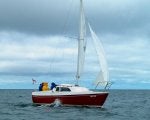
I have done nothing structuraly to my deck. The boat uses plywood backing plates under the hardware, and this is what you are seeing in those pics. They seem to be glued in place and then the edges of the plywood camfered back to the underside of the deck using some sort of filler. I would not be too concerned about these bits of plywood. They are not the "core" of the laminate but rather glued to the outside of the laminate on the bottom. At least on my boat. This winter, I may try to peel some of these backing plates off and replace with aluminium. We will see. The core on the early DS boats was regular 1/4" pegboard. I guess the thought was that since it has holes every few inches, it would allow the top and bottom layers of the laminate to be bonded together thru the holes. The pegboard was used on the cabin top and forward deck. I suppose it could get wet and rot, but mine seems to be pretty solid and the peg board doesn't seem to wick a lot of water the way balsa core does. If you look closely, you can see the pegboard holes as dimples in the laminate. See pic below. Look closely where the light reflects on the center part of the hatch. My boat needs some smaller bulkheads below the cockpit replaced, altho I sailed it all summer as is. Mine are not rotten, but rather delaminated from the tabbing due to being wet for so long. The bilge on these boats is shallow and wide, so any water in the bilge covers a large area, and right up against a plywood bulkhead (the one that keeps bilge water out of the cabin). I plan on replacing these bulkheads with sheets of solid 1/4" fiberglass and then tabbing them in. Eric
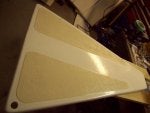
Here is the state of my bilge area and the two bulkheads in question. These seem to have been replaced once before. These will be replaced with fiberglass sheets. Everything will be cleaned up and painted too. Eric

- ?
- 176.4K members
Top Contributors this Month
The Ds 20 is a 20.42ft fractional sloop designed by Diller & Schwill and built in fiberglass by DS Yachts (Schwill Yachts) (CAN) between 1972 and 1983.
The Ds 20 is a light sailboat which is a good performer. It is stable / stiff and has a low righting capability if capsized. It is best suited as a day-boat. There is a very short water supply range.
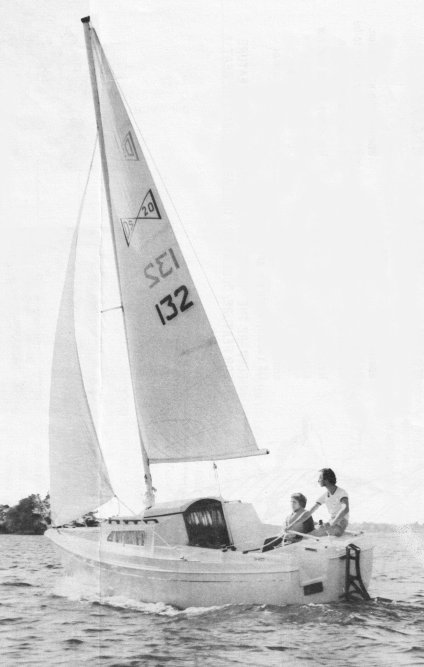
Ds 20 for sale elsewhere on the web:

Main features
| Model | Ds 20 | ||
| Length | 20.42 ft | ||
| Beam | 7.58 ft | ||
| Draft | 1.83 ft | ||
| Country | Canada (North America) | ||
| Estimated price | $ 0 | ?? |
Login or register to personnalize this screen.
You will be able to pin external links of your choice.

See how Sailboatlab works in video
| Sail area / displ. | 18.09 | ||
| Ballast / displ. | 35.14 % | ||
| Displ. / length | 139.97 | ||
| Comfort ratio | 10.25 | ||
| Capsize | 2.47 |
| Hull type | Monohull swing keel | ||
| Construction | Fiberglass | ||
| Waterline length | 18.07 ft | ||
| Maximum draft | 4 ft | ||
| Displacement | 1850 lbs | ||
| Ballast | 650 lbs | ||
| Hull speed | 5.70 knots |

We help you build your own hydraulic steering system - Lecomble & Schmitt
| Rigging | Fractional Sloop | ||
| Sail area (100%) | 170 sq.ft | ||
| Air draft | 28 ft | ||
| Sail area fore | 73.87 sq.ft | ||
| Sail area main | 95.79 sq.ft | ||
| I | 17.80 ft | ||
| J | 8.30 ft | ||
| P | 20.60 ft | ||
| E | 9.30 ft |
| Nb engines | 1 | ||
| Total power | 0 HP | ||
| Fuel capacity | 0 gals |
Accommodations
| Water capacity | 20 gals | ||
| Headroom | 0 ft | ||
| Nb of cabins | 0 | ||
| Nb of berths | 0 | ||
| Nb heads | 0 |
Builder data
| Builder | DS Yachts (Schwill Yachts) (CAN) | ||
| Designer | Diller & Schwill | ||
| First built | 1972 | ||
| Last built | 1983 | ||
| Number built | 0 | ?? |
Other photos
Modal title.
The content of your modal.
Personalize your sailboat data sheet
ShortyPen.com
- Board Boats
- Day Sailors
- Pocket Cruisers
- Multihull Sailboats
- Contributors
- Shorty Articles
- Contact Shorty

| Boat Name | DS 20 | |
| Manufacturer | ||
| Hull Type | Pocket Cruiser | |
| LOA | 20'5" | (6.22m) |
| Beam | 7'7" | (2.31m) |
| Weight | 1850 | (840.83kg) |
| Ballast | 650 | (295.43kg) |
| Keel Type | shoal keel | |
| Berths | 4 | |
| Draft Up | 1'10" | (0.56m) |
| Draft Down | (m) | |
| Year Start | ||
| Year End | ||
| Number Made | ||
| Country | ||
| MIC | ||
| Shortypen ID | 168 | |
| Clone | ||
Great choice! Your favorites are temporarily saved for this session. Sign in to save them permanently, access them on any device, and receive relevant alerts.
- Sailboat Guide
DS-20 is a 20 ′ 4 ″ / 6.2 m monohull sailboat designed by Diller & Schwill and built by DS Yachts (Schwill Yachts) between 1972 and 1983.

Rig and Sails
Auxilary power, accomodations, calculations.
The theoretical maximum speed that a displacement hull can move efficiently through the water is determined by it's waterline length and displacement. It may be unable to reach this speed if the boat is underpowered or heavily loaded, though it may exceed this speed given enough power. Read more.
Classic hull speed formula:
Hull Speed = 1.34 x √LWL
Max Speed/Length ratio = 8.26 ÷ Displacement/Length ratio .311 Hull Speed = Max Speed/Length ratio x √LWL
Sail Area / Displacement Ratio
A measure of the power of the sails relative to the weight of the boat. The higher the number, the higher the performance, but the harder the boat will be to handle. This ratio is a "non-dimensional" value that facilitates comparisons between boats of different types and sizes. Read more.
SA/D = SA ÷ (D ÷ 64) 2/3
- SA : Sail area in square feet, derived by adding the mainsail area to 100% of the foretriangle area (the lateral area above the deck between the mast and the forestay).
- D : Displacement in pounds.
Ballast / Displacement Ratio
A measure of the stability of a boat's hull that suggests how well a monohull will stand up to its sails. The ballast displacement ratio indicates how much of the weight of a boat is placed for maximum stability against capsizing and is an indicator of stiffness and resistance to capsize.
Ballast / Displacement * 100
Displacement / Length Ratio
A measure of the weight of the boat relative to it's length at the waterline. The higher a boat’s D/L ratio, the more easily it will carry a load and the more comfortable its motion will be. The lower a boat's ratio is, the less power it takes to drive the boat to its nominal hull speed or beyond. Read more.
D/L = (D ÷ 2240) ÷ (0.01 x LWL)³
- D: Displacement of the boat in pounds.
- LWL: Waterline length in feet
Comfort Ratio
This ratio assess how quickly and abruptly a boat’s hull reacts to waves in a significant seaway, these being the elements of a boat’s motion most likely to cause seasickness. Read more.
Comfort ratio = D ÷ (.65 x (.7 LWL + .3 LOA) x Beam 1.33 )
- D: Displacement of the boat in pounds
- LOA: Length overall in feet
- Beam: Width of boat at the widest point in feet
Capsize Screening Formula
This formula attempts to indicate whether a given boat might be too wide and light to readily right itself after being overturned in extreme conditions. Read more.
CSV = Beam ÷ ³√(D / 64)
A Mark II version had more interior amenities. A few boats have a shallow draft fixed keel. At least 160 built.
Embed this page on your own website by copying and pasting this code.
- About Sailboat Guide
©2024 Sea Time Tech, LLC
This site is protected by reCAPTCHA and the Google Privacy Policy and Terms of Service apply.
Review of DS-20
Basic specs..
The hull is made of fibreglass. Generally, a hull made of fibreglass requires only a minimum of maintenance during the sailing season. And outside the sailing season, just bottom cleaning and perhaps anti-fouling painting once a year - a few hours of work, that's all.
The boat is equipped with 75.0 liter fresh water capacity.
The boat equipped with a fractional rig. A fractional rig has smaller headsails which make tacking easier, which is an advantage for cruisers and racers, of course. The downside is that having the wind from behind often requires a genaker or a spinnaker for optimal speed.
The DS-20 is equipped with a swing keel. A swing keel is a pivoting lifting keel, allowing to sail both coastal and inland waters.
The boat can enter even shallow marinas as the draft is just about 0.56 - 0.66 meter (1.84 - 2.14 ft) dependent on the load. See immersion rate below.
Sailing characteristics
This section covers widely used rules of thumb to describe the sailing characteristics. Please note that even though the calculations are correct, the interpretation of the results might not be valid for extreme boats.
What is Capsize Screening Formula (CSF)?
The capsize screening value for DS-20 is 2.47, indicating that this boat would not be accepted to participate in ocean races.
What is Theoretical Maximum Hull Speed?
The theoretical maximal speed of a displacement boat of this length is 5.7 knots. The term "Theoretical Maximum Hull Speed" is widely used even though a boat can sail faster. The term shall be interpreted as above the theoretical speed a great additional power is necessary for a small gain in speed.
The immersion rate is defined as the weight required to sink the boat a certain level. The immersion rate for DS-20 is about 85 kg/cm, alternatively 477 lbs/inch. Meaning: if you load 85 kg cargo on the boat then it will sink 1 cm. Alternatively, if you load 477 lbs cargo on the boat it will sink 1 inch.
Sailing statistics
This section is statistical comparison with similar boats of the same category. The basis of the following statistical computations is our unique database with more than 26,000 different boat types and 350,000 data points.
What is Motion Comfort Ratio (MCR)?
What is L/B (Length Beam Ratio)?
What is a Ballast Ratio?
What is Displacement Length Ratio?
What is SA/D (Sail Area Displacement ratio)?
Maintenance
When buying anti-fouling bottom paint, it's nice to know how much to buy. The surface of the wet bottom is about 15m 2 (161 ft 2 ). Based on this, your favourite maritime shop can tell you the quantity you need.
Are your sails worn out? You might find your next sail here: Sails for Sale
If you need to renew parts of your running rig and is not quite sure of the dimensions, you may find the estimates computed below useful.
| Usage | Length | Diameter | ||
| Mainsail halyard | 17.0 m | (55.8 feet) | 8 mm | (5/16 inch) |
| Jib/genoa halyard | 17.0 m | (55.8 feet) | 8 mm | (5/16 inch) |
| Spinnaker halyard | 17.0 m | (55.8 feet) | 8 mm | (5/16 inch) |
| Jib sheet | 6.2 m | (20.4 feet) | 10 mm | (3/8 inch) |
| Genoa sheet | 6.2 m | (20.4 feet) | 10 mm | (3/8 inch) |
| Mainsheet | 15.5 m | (51.0 feet) | 10 mm | (3/8 inch) |
| Spinnaker sheet | 13.7 m | (44.9 feet) | 10 mm | (3/8 inch) |
| Cunningham | 2.8 m | (9.3 feet) | 8 mm | (5/16 inch) |
| Kickingstrap | 5.7 m | (18.6 feet) | 8 mm | (5/16 inch) |
| Clew-outhaul | 5.7 m | (18.6 feet) | 8 mm | (5/16 inch) |
This section is reserved boat owner's modifications, improvements, etc. Here you might find (or contribute with) inspiration for your boat.
Do you have changes/improvements you would like to share? Upload a photo and describe what you have done.
We are always looking for new photos. If you can contribute with photos for DS-20 it would be a great help.
If you have any comments to the review, improvement suggestions, or the like, feel free to contact us . Criticism helps us to improve.

Small Craft Advisor

Reader Boat: DS20 "After School"
Article by Eric Van Andel
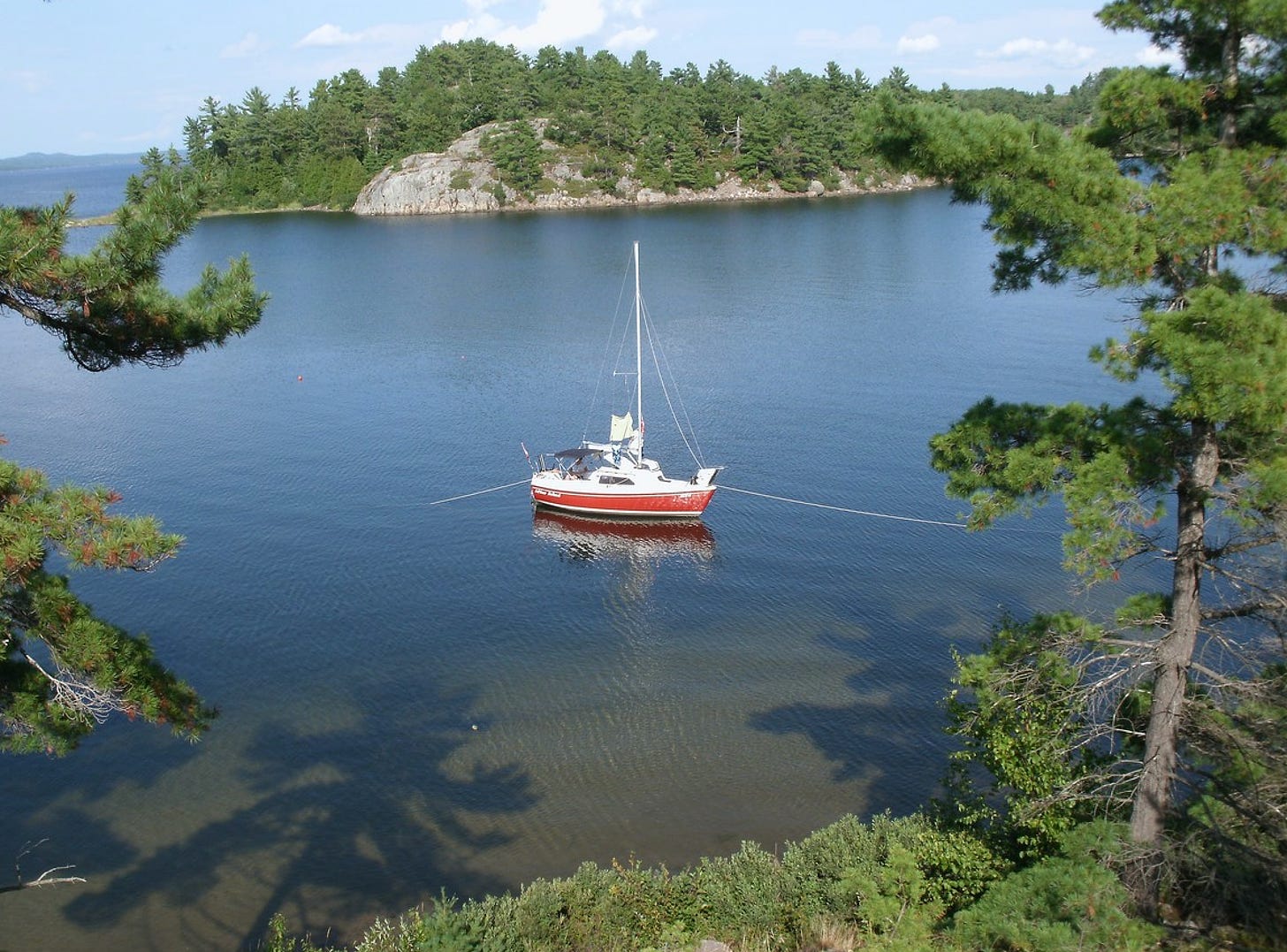
About five years ago, in my early forties, I was a beginning sailor. I bought a 15-foot dinghy to learn on and sailed it on a tiny reservoir north of Woodstock, my hometown in southwestern Ontario. After one season, I knew I wanted something a little larger. It had to be trailerable, maybe about 20 feet in length. Oh, and I wanted a fixer, and it had to be cheap. Knowing very little about sailboats, those were really my only criteria. I started looking online at used boats.
I found a 1973 DS20 in a town three hours north. It was red—and ruined. I loved it. He wanted $1500, and I offered him six. He scoffed, suggesting I purchase a canoe. I was devastated, but not as devastated as I am stubborn, so I left. A week later another red DS20 appeared online. Same year, same price, different boat, different seller. Again I make a long drive. Again, it’s perfect: bad bulkheads, sketchy sails, rough rigging, tattered trailer, and profound potential. Again, I offer the guy $600. I wince, but he’s not offended. He seems to be considering it. Now’s my chance, I think. I sweeten the deal, just a little, while pointing out its condition. He sighs, but I can see he trusts me. He knows she will sail again, and to a sailor who has had countless hours of joy on a small sailing vessel, the thought that his vessel might bring joy to another has value that is not expressed in dollars. He agrees, and it’s mine, for $750.
Keep reading with a 7-day free trial
Subscribe to Small Craft Advisor to keep reading this post and get 7 days of free access to the full post archives.
× You are using an outdated browser. Please upgrade your browser to improve your experience.
We Ship Worldwide! | FREE SHIPPING! for US Continental orders over $99. Click for details.

Shopping Cart
Your cart is currently empty..
FREE SHIPPING! for US Continental orders over $99 click for details
DS 20 - Sailboat Data, Parts & Rigging

Sailboat data, rig dimensions and recommended sail areas for DS 20 sailboat. Tech info about rigging, halyards, sheets, mainsail covers and more.
Sailboat Data directory for over 8,000 sailboat designs and manufacturers. Direct access to halyards lengths, recommended sail areas, mainsail cover styles, standing rigging fittings, and lots more for all cruising and racing sailboats.
MAURIPRO Sailing offers a full range of sailboat and sailing information to help you find the correct sailboat part, one that properly would fit your sailboat and sailing style. Our sailor's and sailboat owner support team are ready to talk with you about your specific sailing needs, coming regatta, or next sailing adventure.
From all at MAURIPRO, let's Go Sailing!
Copyright © 2024 MAURIPRO Sailing LLC.
|


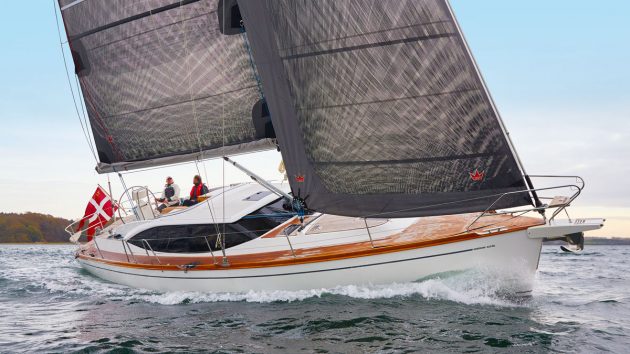





















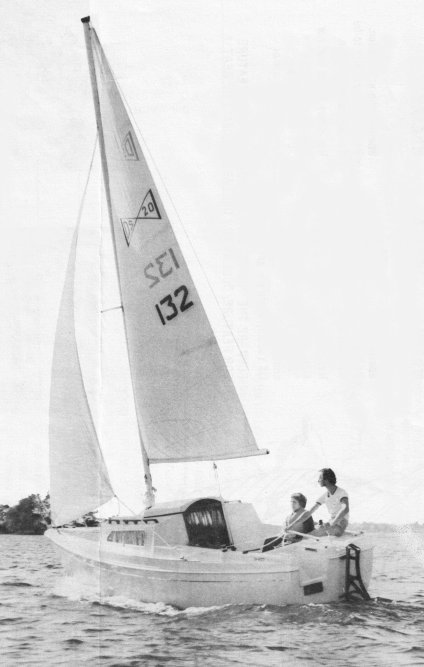
IMAGES
VIDEO
COMMENTS
DS-20 is a swing keel fractional sloop sailboat built by Schwill Yachts from 1972 to 1983. Find its dimensions, calculations, rig and sail details, and join the sailboat forum to discuss it.
Draft 22". Sail Area: 185 sq. ft. Displacement: 1850 lbs. Ballast: 650 lbs. Another pic. The keel is a swing keel but I think it swings into this shoal looking keel. Not sure about how the main is sheeted. I am going to look at the boat this weekend. It's only $1500.00 but is supposed to be in good condition.
The Ds 20 is a 20.42ft fractional sloop designed by Diller & Schwill and built in fiberglass by DS Yachts (Schwill Yachts) (CAN) between 1972 and 1983. The Ds 20 is a light sailboat which is a good performer. It is stable / stiff and has a low righting capability if capsized. It is best suited as a day-boat.
Boat Name: DS 20: Manufacturer: Hull Type: Pocket Cruiser: LOA: 20'5" (6.22m) Beam: 7'7" (2.31m) Weight: 1850 (840.83kg) Ballast: 650 (295.43kg) Keel Type: shoal keel
A Mark II version had more interior amenities. A few boats have a shallow draft fixed keel. At least 160 built. Embed this page on your own website by copying and pasting this code. DS-20 is a 20′ 4″ / 6.2 m monohull sailboat designed by Diller & Schwill and built by DS Yachts (Schwill Yachts) between 1972 and 1983.
The DL-ratio for DS-20 is 139 which categorizes this boat among 'ultra light racers'. Heavy Light 73% 0 50 100. 73% of all similar sailboat designs are categorized as heavier. A light displacement requires less sailarea and has higher accellerations.
DS Yachts (Schwill Yachts) (CAN) Founded by Herman Schwill. Original contact information: Schwill Yachts. Factory St., Odessa, Ontario CAN. No longer in business. Years in Business: 1971 - 1986. Sailboats Built By DS Yachts (Schwill Yachts) (CAN) (Dates indicate when boat was first built by any builder)
Find out the specifications, price range, and features of the DS 20, a cruising sailboat with a boxy design and a lot of interior space. Learn about the different keel options and the vertical clearance of this boat.
The immersion rate is defined as the weight required to sink the boat a certain level. The immersion rate for Ds 20 is about 85 kg/cm, alternatively 477 lbs/inch. Meaning: if you load 85 kg cargo on the boat then it will sink 1 cm. Alternatively, if you load 477 lbs cargo on the boat it will sink 1 inch.
This DS 20 sailboat has a fiberglass hull and an LOA of 20.42 feet (length over all). The boat has a 77 inch beam. This sailboat is set up to sail as a Sloop. The craft has 185 square feet of sail area. Displacement for the boat is 1850 lbs. The draft of this sailboat is approximately 1'10". (For those brand new to sailing, draft is important ...
This DS sailboat has a hull made of fiberglass and has an overall length of 20.42 feet. The beam (or width) of this craft is 75 inches. This sailboat is rigged as a Sloop. The sail area for the boat is 185 square feet. Approximate displacement for the vessel comes in at around 1650 pounds.
He agrees, and it's mine, for $750. The DS20 was a Canadian made boat built by Diller-Schwill, AKA Schwill Yachts, of Odessa, Ontario. It was built from 1973 to the mid eighties sometime. They also made a 16 and 22 footer. Mine was an early one, built in 1973, sail number 27. I like it because it's a roomy boat.
Sailboat data, rig dimensions and recommended sail areas for DS 20 sailboat. Tech info about rigging, halyards, sheets, mainsail covers and more.
Go to Sailing Texas classifieds for current sailboats for sale . 1977 DS 20 shoal draft cruiser. High freeboard, great for the coast or any beginning sailor. Ideal for two adults and two kids. Needs paint all over, and minor marine-tex touch up.
Cal 20 preowned sailboats for sale by owner. Cal 20 used sailboats for sale by owner. Home. Register & Post. View All Sailboats. Search. Avoid Fraud. ... 39' Jeanneau Sun Odyssey 40 DS Chagaramus Trinidad, Asking $109,500. 25.5' Ericson 25 Stratford, Connecticut Asking $5,800. 36' Chung Hwa Magellan San Carlos Mexico
The 1976 DS 20 sailboat has a fiberglass hull and has an overall length of 20.42 feet (sometimes referred to as LOA). The width (or beam) of this craft is 77 inches. This boat is rigged as a Sloop. The sail area for the sailboat is 185 square feet. The displacement for the boat is approximately 1850 lbs.
The Sunchaser DS20 is a 6.12 meters self-propelled pontoon with accommodation for 10 people and a draft of 0.60 meters. The Sunchaser DS20 is no longer in production and the price of used models varies. Please contact the itBoat team for more information on used boats and pricing details. Length. 6.12 m / 20' 1".
Deck Saloon sailing vessels pricing. Deck Saloon sailing vessels for sale on YachtWorld are listed for a swath of prices from $39,666 on the relatively lower-priced, classic models all the way up to $10,511,766 for the most extravagant models.
The Nordship 420 DS is a centre cockpit, deck saloon yacht with a raised saloon, a large owner's cabin and a vee berth. It offers excellent workmanship, build quality and customisation options, but has some drawbacks such as a high helm position and a small cockpit locker.
DS-16 is a 16-foot keelboat designed by G. Diller and H. Schwill and built by Schwill Yachts since 1970. Find out its dimensions, calculations, rig and sail particulars, and join the sailboat forum to discuss it.
All groups and messages ... ...
Built by DS Yachts (Schwill Yachts) (CAN) and designed by undefined, the boat was first built in 1972. It has a hull type of Swing Keel and LOA is 6.22. Its sail area/displacement ratio 18.09. Its auxiliary power tank, manufactured by undefined, runs on undefined. DS-20 has retained its value as a result of superior building, a solid reputation ...